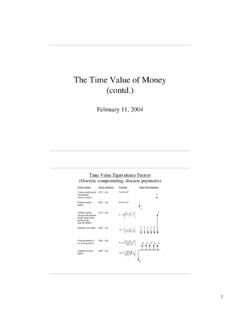Transcription of Status Report BWRX-300 (GE Hitachi and Hitachi GE Nuclear ...
1 Status Report BWRX-300 (GE Hitachi and Hitachi GE Nuclear Energy) USA DATE (2019/9/30) The BWR-300 is the 10th generation Boiling Water Reactor (BWR) crated by GE Hitachi Nuclear Energy (GEH). It is a SMR evolution of the ESBWR which is licensed by the US NRC and utilizes many of the components for the operational ABWR. The first BWRX-300s are expected to start construction in in 2024 and 2025 and enter commercial operation in 2027 and 2028. INTRODUCTION Development Milestones 2014 ESBWR DCD Issued 2017 BWRX-300 Evolution from ESBWR Initiated 2018 Pre-licensing engagement with the UK ONR 2019 Start of US NRC pre-licensing engagement including Licensing Topical Report Submittal 2020 Start of Canadian CNSC Vendor Design Review Combined Phase 1 and 2 2022 Submittal of construction permit application in US and Canada2024/5 Start of construction in US and Canada 2027/28 Commercial Operation in US and Canada Design organization or vendor company (e-mail contact): GEH Home Page.
2 The BWRX-300 is a designed-to-cost, 300 MWe water-cooled, natural circulation Small Modular Reactor (SMR) utilizing simple, natural phenomena driven safety systems. It is Indicate which booklet(s): [ ] Large WCR [ ] SMR [ ] FR GE Hitachi Nuclear Energy s (GEH s) BWRX-300 is a designed-to-cost, 300 MWe water-cooled, natural circulation Small Modular Reactor (SMR) utilizing simple, natural phenomena driven safety systems. It is the tenth generation of the Boiling Water Reactor (BWR) and represents the simplest, yet most innovative BWR design since GE, GEH s predecessor in the Nuclear business, began developing Nuclear reactors in 1955.
3 The BWRX-300 is an evolution of the NRC-licensed, 1,520 MWe ESBWR. It is designed to provide clean, flexible energy generation that is cost competitive with natural gas fired plants. Target applications include base load electricity generation, load following electrical generation within a range of 50 to 100% power and district heating. GEH, a world-leading provider of advanced reactor technology and Nuclear services, is a global alliance created by the General Electric Company (GE) and Hitachi , Ltd. to serve the global Nuclear industry. being developed by GE- Hitachi Nuclear Energy (GEH) in the USA and Hitachi GE Nuclear Energy (HGNE) in Japan.
4 It is the tenth generation of the Boiling Water Reactor (BWR) and represents the simplest, yet most innovative BWR design since the General Electric Company (GE), GEH s predecessor in the Nuclear business, began developing Nuclear reactors in 1955. The BWRX-300 is an evolution of the NRC-licensed, 1,520 MWe ESBWR. It is designed to provide clean, flexible energy generation that is cost competitive with natural gas fired plants. Target applications include base load electricity generation, load following electrical generation within a range of 50 to 100% power and district heating. The BWRX-300 design optimizes the cost of construction, operation, maintenance, staffing and decommissioning.
5 Cost are minimized while maintaining world class safety by implementing a safety assessment framework structured on the five defense lines of IAEA s Defense-in-Depth methodology. GEH s intense focus on minimizing all aspects of cost was driven by discussions with multiple GEH customers who indicated that new Nuclear will only be built in significant quantities if it is cost competitive with all forms of new energy generation. Focusing on cost was also borne out as the only path to significant new Nuclear generation in a 2018 EPRI Report that determined that advanced Nuclear power generation is insensitive to displacing other power generating technologies in the USA by 2050 unless the capital cost is less than $3,000 USD/kW.
6 Additionally, MIT research determined that future Nuclear power installations will need to come from proven Nuclear steam supply system (NSSS) supply chains and standard, modularized, off-the-shelf equipment at an overnight EPC capital cost less than $2,500 USD/kW. The top-level features of the BWRX-300 include: 10th generation BWR technology 300 MWe SMR Comply with the international high safety standards Designed to be cost competitive with gas Up to 60% capital cost reduction per MW Evolved from the licensed ESBWR Designed to mitigate LOCAs with a simple, dry containment without relying on active safety systems Reduced on-site staff and security Design-to-cost approach.
7 <$1B USD first of a kind (FOAK) and <$2,250 USD/kW nth of a kind (NOAK) Proven components, fuel, and supply chain Constructability integrated into design Additional details can be found on the GE Hitachi web site. Table 1: ARIS Category Fields (see also Spreadsheet Categories ) for Booklet ARIS Category Input Select from Current/Intended Purpose Commercial Electric, District Heating Commercial Electric/Non-electric, Prototype/FOAK, Demonstration, Experimental Main Intended Application (once commercial) Baseload Baseload, Dispatchable, Off-grid/Remote, Mobile/Propulsion, Non-electric (specify) Reference Location Below-Ground On Coast, Inland, Below-Ground, Floating-Fixed, Marine-Mobile, Submerged-Fixed (Other-specify) Reference Site Design (reactor units per site)
8 Single Unit Single Unit, Dual Unit, Multiple Unit (# units) Reactor Core Size (1 core) Small Small (<1000 MWth), Reactor Type BWR Medium (1000-3000 MWth), Core Coolant H2O Large (>3000 MWth) Neutron Moderator H2O PWR, BWR, HWR, SCWR, GCR, GFR, SFR, LFR, MSR, ADS NSSS Layout Direct-cycle H2O, D2O, He, CO2, Na, Pb, PbBi, Molten Salts, (Other-specify) Primary Circulation Natural H2O, D2O, Graphite, None, (Other-specify) Thermodynamic Cycle Rankine Loop-type (# loops), Direct-cycle, Semi-integral, Integral, Pool-type Secondary Side Fluid n/a Forced (# pumps), Natural Fuel Form Fuel Assembly/Bundle Rankine, Brayton, Combined-Cycle (direct/indirect) Fuel Lattice Shape Square H2O, He, CO2, Na, Pb, PbBi, Molten Salts, (Other-specify) Rods/Pins per Fuel Assembly/Bundle 92 Fuel Assembly/Bundle, Coated Sphere, Plate, Prismatic, Contained Liquid, Liquid Fuel/Coolant Fuel Material Type Oxide Square, Hexagonal, Triangular, Cylindrical, Spherical, Other, n/a Design Status Conceptual #, n/a Licensing Status DCR Oxide, Nitride, Carbide, Metal, Molten Salt, (Other-specify) Table 2.
9 ARIS Parameter Fields (see also Spreadsheet Data ) for Booklet ARIS Parameter Value Units or Examples Plant Infrastructure Design Life 60 years Lifetime Capacity Factor 95 %, defined as Lifetime MWe-yrs delivered / (MWe capacity * Design Life), incl. outages Major Planned Outages 10-20 days every 12-24 months (refuelling) 25 days every 120 months (major turbine inspection and ISI on reactor vessel and internals) # days every # months (specify purpose, including refuelling) Operation / Maintenance Human Resources ~75 total # Staff in Operation / Maintenance Crew during Normal Operation Reference Site Design 1 n Units/Modules Capacity to Electric Grid 270-290 MWe (net to grid) Non-electric Capacity Flexible In-House Plant Consumption 10-30 MWe Plant Footprint 8,400 m2 (rectangular building envelope)
10 Site Footprint 26,300 m2 (fenced area) Emergency Planning Zone 1 (At site boundary) km (radius) Releases during Normal Operation +1 / / TBq/yr (Noble Gases / Tritium Gas / Liquids) Load Following Range and Speed 50 100% daily, per minute Seismic Design (SSE) g (Safe-Shutdown Earthquake) ARIS Parameter Value Units or Examples NSSS Operating Pressure (primary/secondary) / n/a MPa(abs) Primary Coolant Inventory (incl. pressurizer) 1,820,000 kg Nominal Coolant Flow Rate (primary/secondary) 1,530 / n/a kg/s Core Inlet / Outlet Coolant Temperature 270 / 287 C / C Available Temperature as Process Heat Source Flexible 100-200 C NSSS Largest Component Reactor Pressure Vessel (RPV) - dimensions 26 / 4 / 485,000 m (length) / m (diameter) / kg (transport weight) Reactor Vessel Material SA508 Steam Generator Design n/a Secondary Coolant Inventory n/a Pressurizer Design n/a Pressurizer Volume n/a Containment Type and Total Volume Dry(single, underground)




